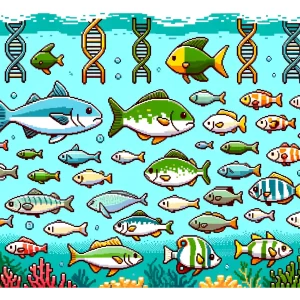
Invasive Species: Another Threat Beneath the Surface
Biological invasions are rapidly emerging as one of the major threats to biodiversity, ecosystem processes, and socio-economic stability in the Anthropocene. These invasions occur when non-native species are introduced, either accidentally or intentionally, into new geographic regions where they lack an evolutionary history. This can lead to significant adverse effects, including the local extinction of native species, the spread of diseases, and disruptions in ecosystem functioning. As these invasions continue to escalate globally, understanding the factors that enable non-native species to spread and devising effective mitigation strategies are crucial.
The Invasion Process: A Four-Stage Journey
Biological invasions unfold in four stages: transportation, introduction, establishment, and spread. Each stage carries potential impacts that can disrupt local ecosystems. Despite advancements in understanding these invasions, there are still many challenges in screening and assessing the impacts of invasive species. Traditional metrics like species richness, abundance, and spread speed often fall short in providing a standardized quantitative measure for invasions across different contexts.
The Importance of Population-Level Analysis
A significant gap in invasion science is the lack of focus on the population level. Most studies and assessments are conducted at the species level, which overlooks the nuanced, context-dependent dynamics of invasive populations. Natural selection plays a crucial role in shaping these dynamics, influencing traits that affect survival and reproduction. This means that understanding the invasion process requires detailed temporal data and information on environmental factors affecting non-native populations.
Case Study: Aquatic Invasive Species in Europe
A comprehensive analysis of aquatic species in European freshwaters reveals significant variability in invasion dynamics. The study examined long-term time series data from 22 European countries, focusing on six common invasive species: the New Zealand mud snail, zebra mussel, killer shrimp, amphipod, bladder snail, and gravel snail.

- Spreading Speed: The spreading speed of these species varied significantly across different regions and over time. For example, the zebra mussel showed a wide range of spreading speeds, indicating different invasion dynamics in different countries. This variability underscores the need to consider local environmental conditions and population-specific traits when assessing invasiveness.
- Abundance Trends: The abundance of non-native populations showed diverse trends, with some populations increasing, some decreasing, and others remaining stable. This highlights the complexity of invasion dynamics and the influence of local factors such as environmental conditions and biotic interactions.
The Flaws of Species-Level Assessments
Species-level assessments, such as the widely known “100 of the World’s Worst Invasive Species” list, often fail to capture the complex dynamics of biological invasions. These lists are based on broad criteria that do not consider local context dependencies, leading to ineffective management strategies. A population-level approach, on the other hand, allows for more accurate assessments and targeted interventions tailored to the specific characteristics of each invasive population.
Moving Towards Population-Level Risk Assessments
There is an urgent need to shift from species-level to population-level risk assessments in invasion science. This approach aligns with the mechanistic foundations of natural selection theory and provides a more comprehensive understanding of how invasive species interact with their environments. By focusing on population dynamics, we can develop more effective conservation and mitigation measures.
Practical Implications for Management Strategies
Adopting a population-level perspective has significant implications for invasion management. It allows for the identification of specific traits or conditions that drive invasiveness, enabling targeted interventions. For instance, understanding the spread dynamics of invasive species can inform strategies to prevent their further spread and mitigate their impacts.
The Path Forward
Invasion science needs to follow the example of biodiversity monitoring advancements like the Living Planet Index, which focuses on regional population trajectories to assess ecological risk. Recognizing invasions as a population-level phenomenon is essential for advancing our understanding of biological invasions and developing effective management strategies.
Let Us Know Your Thought!t
- How can local communities contribute to monitoring and managing invasive species in their areas?
- What are some successful examples of population-level management strategies for invasive species?
Conclusion
Biological invasions pose a significant threat to biodiversity and ecosystem stability. Moving towards a population-level approach in invasion science is crucial for understanding the complex dynamics of invasive species and developing effective management strategies. By recognizing the importance of local context dependencies and natural selection processes, we can better address the challenges posed by biological invasions and protect our natural ecosystems.
Explore, Learn, and Grow with Science:
Step into the realm of discovery with ‘This Week in Science’! Tailored for both educators and science enthusiasts, our newsletter offers a weekly exploration of groundbreaking research and inspiring stories from the scientific community. By subscribing, you’re not just reading – you’re expanding your horizons in teaching and learning. Join us for free and start a journey that reshapes your engagement with science, fostering a more informed and passionate approach.
About the Author
Jon Scaccia, with a Ph.D. in clinical-community psychology and a research fellowship at the US Department of Health and Human Services with expertise in public health systems and quality programs. He specializes in implementing innovative, data-informed strategies to enhance community health and development. Jon helped develop the R=MC² readiness model, which aids organizations in effectively navigating change.



